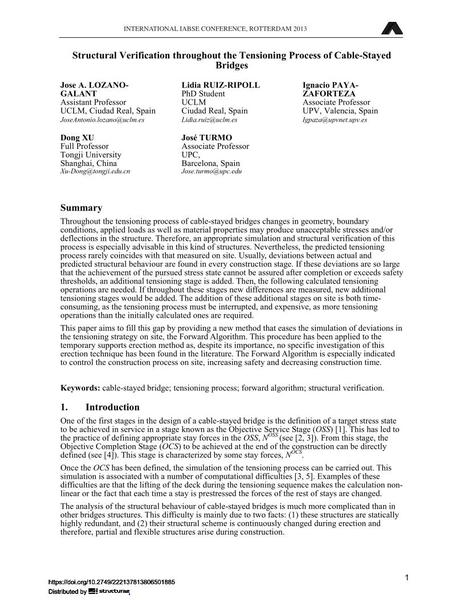Structural Verification throughout the Tensioning Process of Cable-Stayed Bridges

|
|
|||||||||||
Bibliografische Angaben
| Autor(en): |
Jose A. Lozano-Galant
Lidia Ruiz-Ripoll Ignacio Payá-Zaforteza Dong Xu José Turmo |
||||
|---|---|---|---|---|---|
| Medium: | Tagungsbeitrag | ||||
| Sprache(n): | Englisch | ||||
| Tagung: | IABSE Conference: Assessment, Upgrading and Refurbishment of Infrastructures, Rotterdam, The Netherlands, 6-8 May 2013 | ||||
| Veröffentlicht in: | IABSE Conference, Rotterdam, May 2013 | ||||
|
|||||
| Seite(n): | 416-417 | ||||
| Anzahl der Seiten (im PDF): | 7 | ||||
| Jahr: | 2013 | ||||
| DOI: | 10.2749/222137813806501885 | ||||
| Abstrakt: |
Throughout the tensioning process of cable-stayed bridges changes in geometry, boundary conditions, applied loads as well as material properties may produce unacceptable stresses and/or deflections in the structure. Therefore, an appropriate simulation and structural verification of this process is especially advisable in this kind of structures. Nevertheless, the predicted tensioning process rarely coincides with that measured on site. Usually, deviations between actual and predicted structural behaviour are found in every construction stage. If these deviations are so large that the achievement of the pursued stress state cannot be assured after completion or exceeds safety thresholds, an additional tensioning stage is added. Then, the following calculated tensioning operations are needed. If throughout these stages new differences are measured, new additional tensioning stages would be added. The addition of these additional stages on site is both time- consuming, as the tensioning process must be interrupted, and expensive, as more tensioning operations than the initially calculated ones are required. This paper aims to fill this gap by providing a new method that eases the simulation of deviations in the tensioning strategy on site, the Forward Algorithm. This procedure has been applied to the temporary supports erection method as, despite its importance, no specific investigation of this erection technique has been found in the literature. The Forward Algorithm is especially indicated to control the construction process on site, increasing safety and decreasing construction time. |
||||
| Stichwörter: |
Schrägseilbrücke
|
||||

